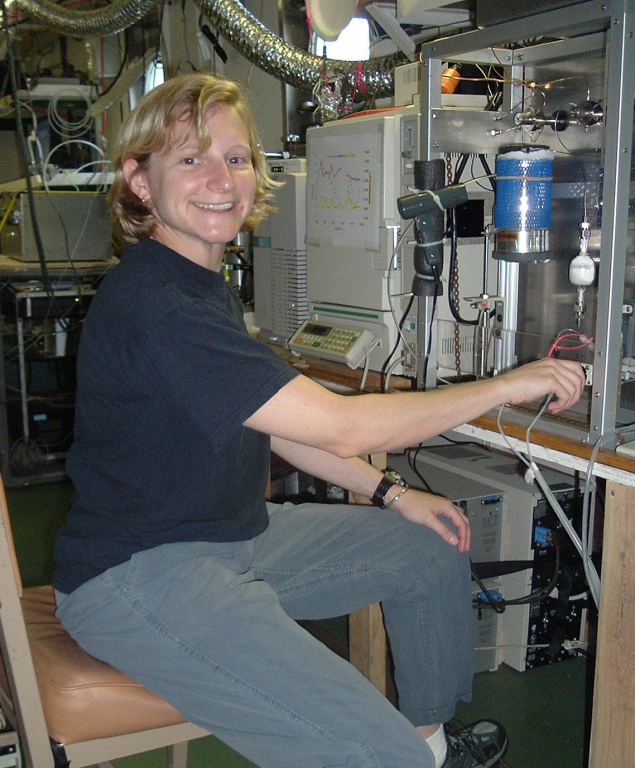The lab contains a variety of instruments for detecting trace gases in air and natural waters.
Some of our major instruments are:
Gas chromatographs with mass spectrometric detection

Three automated GC/MS systems with quadrupole mass selective detectors (Agilent 5973) are used in seagoing and laboratory work for analysis of trace halocarbons, oxygenated organics, sulfur gases, and alkyl nitrates. These systems have automated cryotraps that use pneumatics to move liquid nitrogen dewars up and down, and resistance heating to desorb gases. A new version of this has recently been constructed for highly volatile fluorinated gases like CF4 and NF3. The photo here shows a system in use on the R/V Wecoma in the equatorial Pacific for measurement of the lifetime of methyl bromide in seawater. This application used an internal standard of deuterated methyl bromide to achieve very high precision. All of these systems use PC-based software (“System Control”) which was developed jointly by our lab and Shari Yvon-Lewis at Texas A&M.
Atmospheric pressure, chemical ionization mass spectrometers (API-CIMS)

These are used for the detection of reactive trace gases in air. Homemade API/CIMS instruments based onExtrel components use atmospheric pressure ionization techniques and quadrupole mass filtering to achieve high sensitivity and rapid time response for gases like dimethylsulfide, acetone, and sulfur dioxide. This instrument has been used primarily for shipboard flux measurements using eddy covariance.
Our laboratory has also developed an API/CIMS based on the Stanford Research Systems Residual Gas Analyzer. This compact instrument, called the UCI mini-CIMS, is designed for measuring dissolved gases in seawater. It is used in conjunction with a membrane equilibrator to continuously transfer gases from seawater into an air stream. The mini-CIMS has been deployed on several oceanographic cruises – including the Malaspina 2010 global circumnavigation.
Micromass Autospec Ultima (Waters, Inc.) double-focusing magnetic sector mass spectrometer, with automated gas inlet
This instrument is used to measure trace halocarbons, hydrocarbons, sulfur, and nitrogen gases in air. It has exact mass resolution and extremely high sensitivity. We use it to analyze small air samples extracted from the bubbles in polar ice cores, air pumped from polar firn, and air in glass flasks obtained from various stations around the world sampled by the NOAA flask air sampling network. The GC/MS has a steel gas inlet to process air samples for injection. The inlet adds a small volume of a gas standard containing stable isotope-labeled trace gases as an internal standard for quantification.
Thermo-Finnigan TSQ Quantum – electrospray triple-quadruple mass spectrometer

This instrument is being used for the measurement of atmospheric tracers in ice cores and aerosols. We do this by direct electrospray analysis of melted ice cores or aerosol extracts, or by HPLC/MS with electrospray. We have built chemical ionization ion sources to adapt this mass spectrometer for gas phase measurements of reactive halogen gases. The photo shows the instrument with a whole air ionization source (Ni-63) as configured for negative ion Cl2 measurements in air on the Cape Verde Islands.

